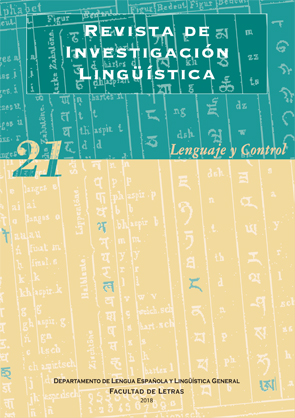Estilos de gestión de los perfiles políticos en Twitter
imagen y texto en las cuentas de los partidos en la campaña del 26J
Resumen
En este trabajo analizamos dos aspectos de las cuentas de los partidos políticos en Twitter durante la campaña del 26J: la estructura semiótica de los tuits y su función comunicativa. El análisis de estas dos variables permite concluir que 1) las cuentas de los partidos carecen en general de voz institucional y tienen sobre todo carácter ecoico respecto a las cuentas de los líderes, especialmente los candidatos; 2) existe equilibrio entre el uso de texto e imagen; 3) la función predominante es el tuit de cita; 4) las cuentas son uniformes, solo destaca la de IZQUIERDA UNIDA por su alto índice de espectacularización de la política. No hay, en definitiva, un estilo de gestión específico para la comunicación del partido en la red social.
Descargas
-
Resumen1243
-
PDF1359
Citas
ABEJÓN, Paloma et al. (2017): “El uso de webs, Facebook y Twitter en la comunicación electoral española de 2015: una mirada impresionista”,en J.L.
Dader y E. Campos (Coords): La búsqueda digital del voto. Cibercampañas electorales en España 2015-2016. València: Tirant Lo Blanch, 75-140.
ABRIL, Gonzalo (2013): Cultura visual, de la semiótica a la política, Madrid: Plaza y Valdés.
AUTY, Caroline & COWEN, Alison (2001): “Political parties on the Net – 4 years closer to cyber-utopia?” en Aslib Proceedings 53.9, pp.340-352. http:// www.emeraldinsight.com/doi/pdfplus/10.1108/EUM0000000007066
BLUMENTHAL, Sidney (1980): The Permanent Campaign: Inside the World of Elite Political Operatives, Boston, Beacon.
CASTELLS, Manuel (2008): Castells, Manuel (2008): “Comunicación, poder y contrapoder en la sociedad red (I). Los medios y la política”, TELOS 74, https://telos.fundaciontelefonica.com/telos/articuloautorinvitado.asp@idarticulo=1&rev=74.htm
CHECA GODOY, Antonio (2013): El cartel. Dos siglos de publicidad y propaganda. Sevilla: Advook Editorial.
DADER, José Luis (2017): “Campañas políticas ‘online’: la realidad española frente al horizonte internacional del ‘tecnocabildeo’”, en J.L. Dader y E. Campos (Coords): La búsqueda digital del voto. Cibercampañas electorales en España 2015-2016. València: Tirant Lo Blanch, 11-73.
ENGUIX OLIVER, Salvador (2017): “Impacto político e informativo de las redes sociales: esferas de actuación y comparación con los medios” en Anàlisi. Quaderns de Comunicació i Cultura, 56, 71-85. http://analisi.cat/article/view/n56-enguix
GALLARDO PAÚLS, Beatriz & ENGUIX OLIVER, Salvador (2016): Pseudopolítica. El discurso político en las redes sociales. Valencia: Universitat.
GALLARDO PAÚLS, Beatriz (2014): Usos políticos del lenguaje. Un discurso paradójico. Barcelona: Anthropos/Siglo XXI.
GALLARDO PAÚLS, Beatriz (2016): “Programas de tertulia política en Twitter: un modelo neurocomunicativo de análisis del discurso” en CLAC. Círculo de Lingüística Aplicada a la Comunicación, vol 66, 86-147. http://revistas.ucm.es/index.php/CLAC/article/view/52770
GALLARDO PAÚLS, Beatriz (2017): “Pseudopolítica en la red: indicadores discursivos de desideologización en Twitter”, Pragmalingüística 25, 189-210. http://revistas.uca.es/index.php/pragma/article/viewFile/3393/3767
GALLARDO PAÚLS, Beatriz (2018): “Politicians in Twitter: discursive features of personalization in Pseudopolitics”, en Populismi, nuove destre, nuovi partiti: quali discorsi politici in Europa?, Università di Pisa.
GARCÍA-AVILÉS, José Alberto & ARIAS, Félix (2016): “Géneros periodísticos en los formatos visuales de Twitter: uma propuesta de tipologia”. Textual & Visual Media 9, 101-132. http://textualvisualmedia.com/images/revistas/9/articulos/generospe.pdf
JOHNSON-CARTEE, Karen S. (2004): News narratives and news framing: Constructing political reality, Rowman & Littlefield Publishers
LAKOFF, George (2004): No pienses en un elefante. Madrid: UCM, 2007. Trad. de Magdalena Mora.
LAKOFF, George (2006): Puntos de reflexión. Manual del progressista. Barcelona: Eds. Península, 2008. Trad. de Judith Wells.
LÓPEZ RABADÁN, Pablo; LÓPEZ-MERI, Amparo; DOMÉNECH-FABREGAT, Hugo (2016): “La imagen política en Twitter. Usos y estrategias de lospartidos políticos españoles”, Index.Comunicación, 6, 165-195.
MACKEY, Stephen (2016): “Persona – an old public relations problem?” en Persona Studies 2.1 (2016): 84-96. https://ojs.deakin.edu.au/index.php/ps/article/view/533
MARLAND, Alex (2012): “Political Photography, Journalism and Framing in the Digital Age” en Press/Politics 17.2, http://journals.sagepub.com/doi/pdf/10.1177/1940161211433838
NEEDHAM, Catherine (2005): “Brand leaders: Clinton, Blair and the limitations of the permanent campaign”, en Political studies, nº 53 (2), pp. 343-361.
PELLISSER, Nel.lo; VILLAR, Paz & ENGUIX, Salvador (2017): “El vídeo electoral: nuevas estrategias y mensajes en Twitter”. VI Congreso Internacional de Investigadores Audiovisuales. Tecnología y Contenidos Digitales. Universidad Camilo José Cela. 27 y 28 abril 2017.
PRATKANIS, Anthony & ARONSON, Eliot (1992): Age of propaganda. New York: W.H. Freeman and Company.
RUIZ DEL OLMO, Francisco Javier & BUSTOS DÍAZ, Javier (2016): “Del tweet a la fotografía, la evolución de la comunicación política en Twitter hacia la imagen. El caso del Debate del Estado de la Nación en España (2015)” en Revista Latina de Comunicación Social, 71, pp. 108 a 123. http://www.revistalatinacs.org/071/paper/1086/06es.html
USHER, Bethany (2016): “ME, YOU, And US: Constructing political persona on social networks during the 2015 UK General Election” en Persona Studies; 2 (2), http://tees.openrepository.com/tees/bitstream/10149/620899/2/620899.pdf
Las obras que se publican en esta revista están sujetas a los siguientes términos:
1. El Servicio de Publicaciones de la Universidad de Murcia (la editorial) conserva los derechos patrimoniales (copyright) de las obras publicadas, y favorece y permite la reutilización de las mismas bajo la licencia de uso indicada en el punto 2.
2. Las obras se publican en la edición electrónica de la revista bajo una licencia Creative Commons Reconocimiento-NoComercial-SinObrasDerivadas 4.0 (texto legal). Se pueden copiar, usar, difundir, transmitir y exponer públicamente, siempre que: i) se cite la autoría y la fuente original de su publicación (revista, editorial y URL de la obra); ii) no se usen para fines comerciales; iii) se mencione la existencia y especificaciones de esta licencia de uso.
3. Condiciones de auto-archivo. Se permite y se anima a los autores a difundir electrónicamente las versiones pre-print (versión antes de ser evaluada) y/o post-print (versión evaluada y aceptada para su publicación) de sus obras antes de su publicación, ya que favorece su circulación y difusión más temprana y con ello un posible aumento en su citación y alcance entre la comunidad académica. Dulcinea: verde. OPF.









